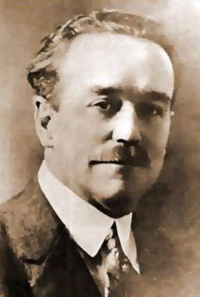
| Part of a series on |
| Pentecostalism |
|---|
 |
| |
Holiness Pentecostalism is the original branch of Pentecostalism, which is characterized by its teaching of three works of grace: [1] the New Birth (first work of grace), [2] entire sanctification (second work of grace), and [3] Spirit baptism evidenced by speaking in tongues (third work of grace). [1] [2] The word Holiness refers specifically to the belief in entire sanctification as an instantaneous, definite second work of grace, in which original sin is cleansed and the believer is made holy, with the heart being made perfect in love. [3] [4] [5]
Contents
- History
- Denominations
- Bible colleges
- Camp meetings
- See also
- References
- Further reading
- External links
Holiness Pentecostalism emerged under the work of ministers Charles Fox Parham and William Joseph Seymour, the latter of whom, beginning in 1906, led the Azusa Street Revival at the Apostolic Faith Gospel Mission. [6] The testimony of those who attended the Azusa Street Revival was "I am saved, sanctified, and filled with the Holy Ghost" in reference to the three works of grace taught by Holiness Pentecostals, the oldest branch of Pentecostalism. [1] The relationship between the second work of grace and the third work of grace is explained by Holiness Pentecostals who teach the "Holy Spirit cannot fill an unclean vessel", so the cleansing of the heart that takes place in entire sanctification is necessary before a person can be filled or baptized with the Holy Spirit. [7] Inheriting the Wesleyan-Holiness doctrine, Holiness Pentecostals teach entire sanctification is a definite second work of grace, accomplished in an instantaneous crisis experience, that cleanses the heart of the recipient from all sin; this state of Christian perfection is evidenced by love for God and love for neighbour. [1] Holiness Pentecostals operate within the framework of Wesleyan (Methodist) theology with the exception of the unique doctrine that distinguishes Holiness Pentecostalism: the Parhamian-Seymourian belief in a third work of grace (in contrast, traditional Wesleyan theology affirms two works of grace—the New Birth and entire sanctification). [8] In the theology of Methodism, entire sanctification (second work of grace) is the baptism of the Holy Spirit, while Holiness Pentecostalism holds the baptism of the Holy Spirit to be the third work of grace. [9] [10] Additionally, while Wesleyan theology of the Methodists holds the second work of grace (entire sanctification) to empower the believer to accomplish that which he/she is called by God to do, in contrast, the Parhamian-Seymourian theology of Holiness Pentecostalism teaches that the believer is empowered through the third work of grace. [11] [12] William Joseph Seymour and Florence Crawford published The Apostolic Faith newsletter, which disseminated the teachings of the Holiness Pentecostal movement. [13]
Holiness Pentecostals teach that believers should dress and behave in a manner becoming unto holiness, and as such, historically, Holiness Pentecostals (such as the Apostolic Faith Church, Calvary Holiness Association and Free Holiness Church) traditionally adhere to the Wesleyan doctrine of outward holiness, which includes modest dress, as well as abstinence from alcohol, tobacco, and other drugs. The holiness standards vary based on the group and while many Holiness Pentecostal denominations such as the Apostolic Faith Church have specific 'holiness standards', other denominations in the present-day, such as the International Pentecostal Holiness Church, have general principles of living contained in their covenant. [14] [15] Holiness Pentecostals observe the Lord's Day with a morning service of worship and an evening service of worship, along with refraining from servile labour and Sunday trading (cf. First-day Sabbatarianism). [16] [17]
Holiness Pentecostals are distinguished from Finished Work Pentecostals, the other branch of Pentecostalism that separated from Holiness Pentecostalism in 1910 under William Howard Durham, who denied the Wesleyan-Holiness doctrine of entire sanctification. [5] [18] [19] [3]


